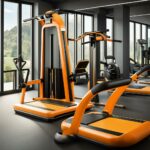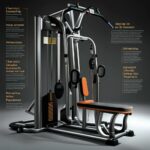https://weightliftingforpower.com/exercise-equipment-maintenance-checklist/
As an exercise enthusiast, gym owner, or individual responsible for maintaining exercise equipment, you hold a significant role in the longevity and safety of your gear. Regular maintenance isn’t just about keeping things running; ensuring your workouts are EFFECTIVE and SAFE is crucial. From the treadmill in your home gym to the weights at your local fitness center, every piece of equipment benefits from your proactive upkeep.

Consider this: the care you invest in your exercise tools impacts the quality of your workouts. A well-maintained treadmill will give you a smoother run, while a neglected machine might lead to hiccups in your routine—or worse, an injury. By neglecting maintenance, you’re not just risking the performance of your equipment but also your safety.
In the following checklist, I’ll cover a range of equipment, emphasizing those items you’re most likely to encounter, from cardio machines to strength-training gear. Rest assured, the maintenance routines I’ll guide you through are stress-free and designed to keep your equipment in top-notch condition without overwhelming you.
Weekly Exercise Equipment Maintenance Routine
Think of your gym gear like a trusted car; you wouldn’t skip oil changes because it keeps the engine humming smoothly. Similarly, investing a little time each week in your exercise equipment can save you from headaches (and costly repairs). Please perform regular maintenance to avoid equipment malfunctions, disrupting your workout routine, and posing a potential safety hazard. For example, a loose bolt on a weight machine could cause the weights to fall unexpectedly, posing a severe risk of injury.

Start with the basics: wiping down equipment after every use. Sweat and bacteria can quickly turn your workout machines into a breeding ground for germs. Utilize a mild disinfectant or a combination of water and gentle detergent to clean the surfaces. It’s not just hygienic; it also preserves the integrity of the materials, helping them last longer. Some recommended tools and products for this task are soft cloth or sponge, mild detergent, or disinfectant spray. Having these on hand will make your maintenance routine more efficient and effective.
Then, take a moment to inspect the equipment for loose nuts, bolts, or parts. A simple tightening with the appropriate tool can prevent wobbles and malfunctions. Think of it like double-checking that your doors are locked before you leave the house; it’s a quick step that offers peace of mind.

Equally important is the need to lubricate moving parts. Without proper lubrication, friction increases, and your equipment can wear out faster than expected. Check your user manual to find the appropriate lubricant, and apply it to areas like chains, pivot points, and rails.
Lastly, always pay attention to the equipment’s safety features. Quick-release pins, safety latches, and emergency stop functions are there for a reason. Please ensure they’re in working order weekly so you’re safe every time you train. Think of it as buckling your seatbelt; it’s an effortless act that could be vital.
Now that you’re equipped with a weekly routine to keep things running, you’ll want to dig deeper once a month. Next, we’ll look into a detailed monthly maintenance routine to catch any underlying issues before they catch you by surprise.
Monthly Detailed Inspection and Maintenance Activities
As the weeks pass and your routine maintenance becomes second nature, setting aside time once a month for more thorough checks can add years to your equipment’s service life. You keep your body in shape by working out; your machines deserve the same comprehensive care. Here are some common maintenance issues and their solutions: loose bolts-tighten with the appropriate tool, squeaky parts lubricant, unresponsive display panels-check for loose connections or dead batteries. Understanding how to handle these issues can prevent them from becoming significant problems.
Let’s begin with deep cleaning. While your weekly wipe-down prevents hygiene issues, monthly cleanings target the nooks and crannies where dust and grime accumulate. A soft cloth and cleaning solution appropriate for your equipment’s material should do the trick.
Please pay attention to belts and tension mechanisms; they require attention. Whether using a treadmill, an elliptical, or resistance equipment, it is essential to ensure that these critical components are neither too tight nor too loose. This action will help to prevent future malfunctions and expensive repairs.
Remember the heart of modern exercise machines: the el ctronics. The monthly routine should include checking display panels for error messages or unresponsiveness. Software updates, if applicable, should also be run to keep the digital aspects as fit as the mechanical ones.
Finally, we must thoroughly inspect frequently used components such as pads, grips, and straps for integrity. Replacing worn items before they entirely give way ensures comfort, upholds safety, and maintains the equipment’s aesthetics, which can motivate you to keep up with your regimen.
When to Seek Professional Maintenance Support
I can’t stress enough how crucial it is to know your limits when maintaining exercise equipment. Sure, you may be handy with a wrench, but for specific problems, call for professional expertise. Not recognizing this can lead to equipment damage or personal injury. Professional maintenance is not a replacement for your weekly and monthly routines but a necessary supplement to ensure your equipment is in optimal condition. They possess the skills and resources to recognize and address issues that may need to be more readily apparent.
Keeping your equipment’s warranty intact often means having a pro look at our gear. Manufacturers usually require professional servicing to keep the warranty valid. It is about abiding by rules and ensuring that potential problems are dealt with quickly.
As a commercial gym or studio owner, you should schedule regular check-ups with a certified technician, a crucial aspect of responsible business ownership. Routine maintenance helps ensure that all equipment complies with industry safety standards, reducing the likelihood of accidents and potential legal liabilities. It also helps extend the lifespan of your equipment, saving you money on costly replacements. Most importantly, it helps provide the best possible experience for your clients, enhancing your gym’s reputation and attracting more members.
Lastly, building a relationship with a maintenance provider can be a gamer. Having a reliable contact just a phone call away ensures you are always supported when maintaining your gear in peak condition. They can provide regular inspections, identify potential issues before they become significant problems, and perform complex repairs that may be beyond your capabilities. Think of them as your fitness equipment’s best friend, someone who helps you keep your routine – and business – running smoothly.
